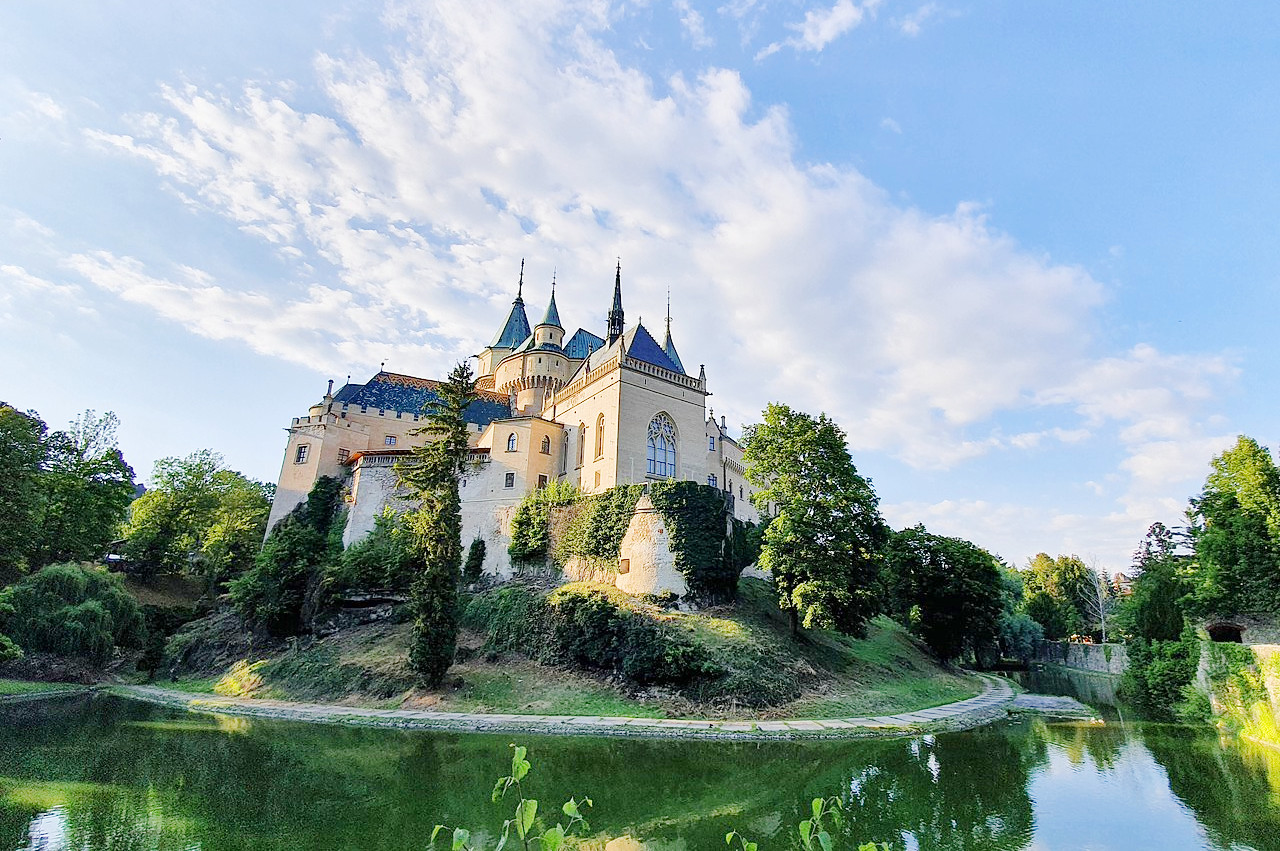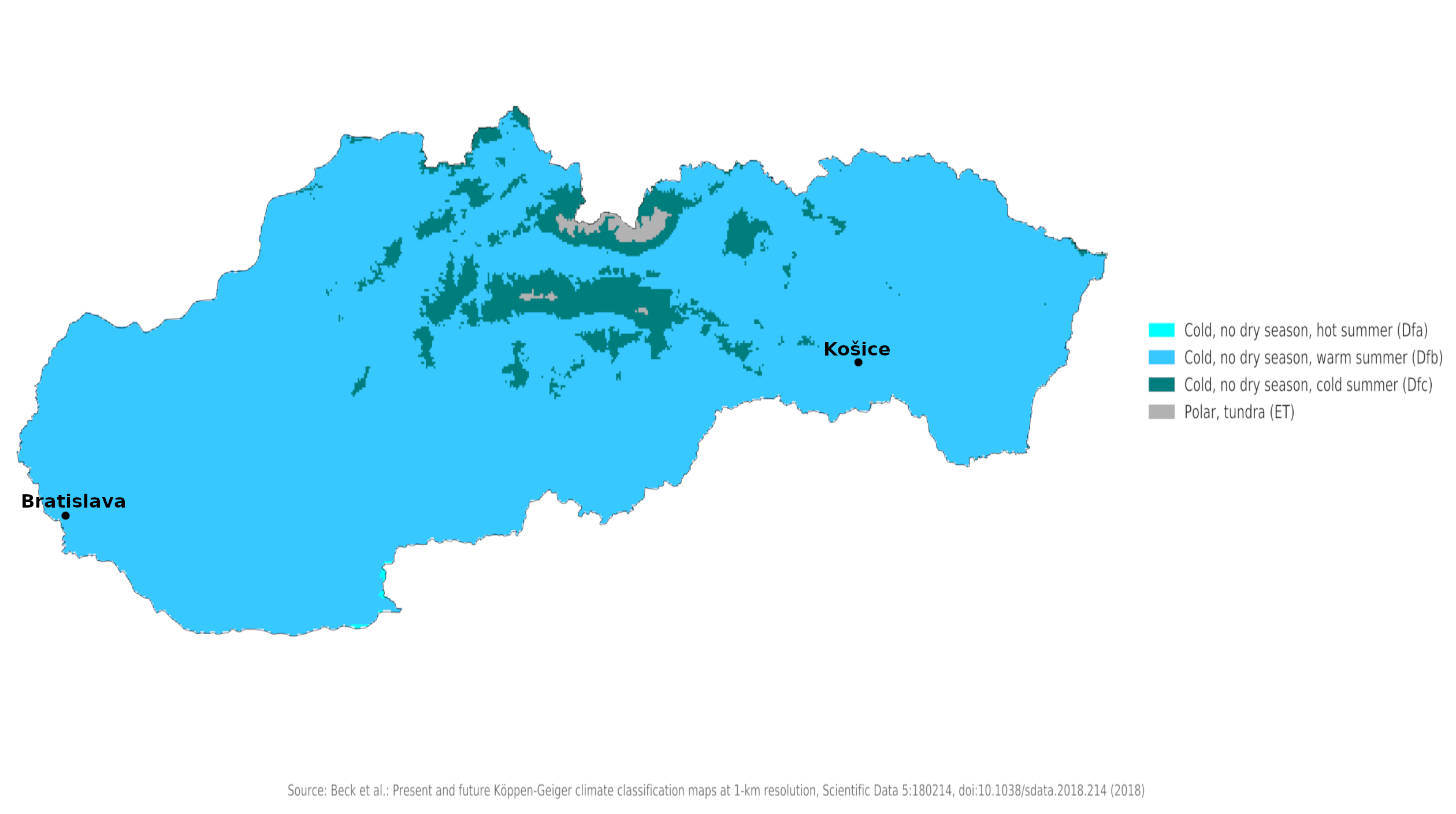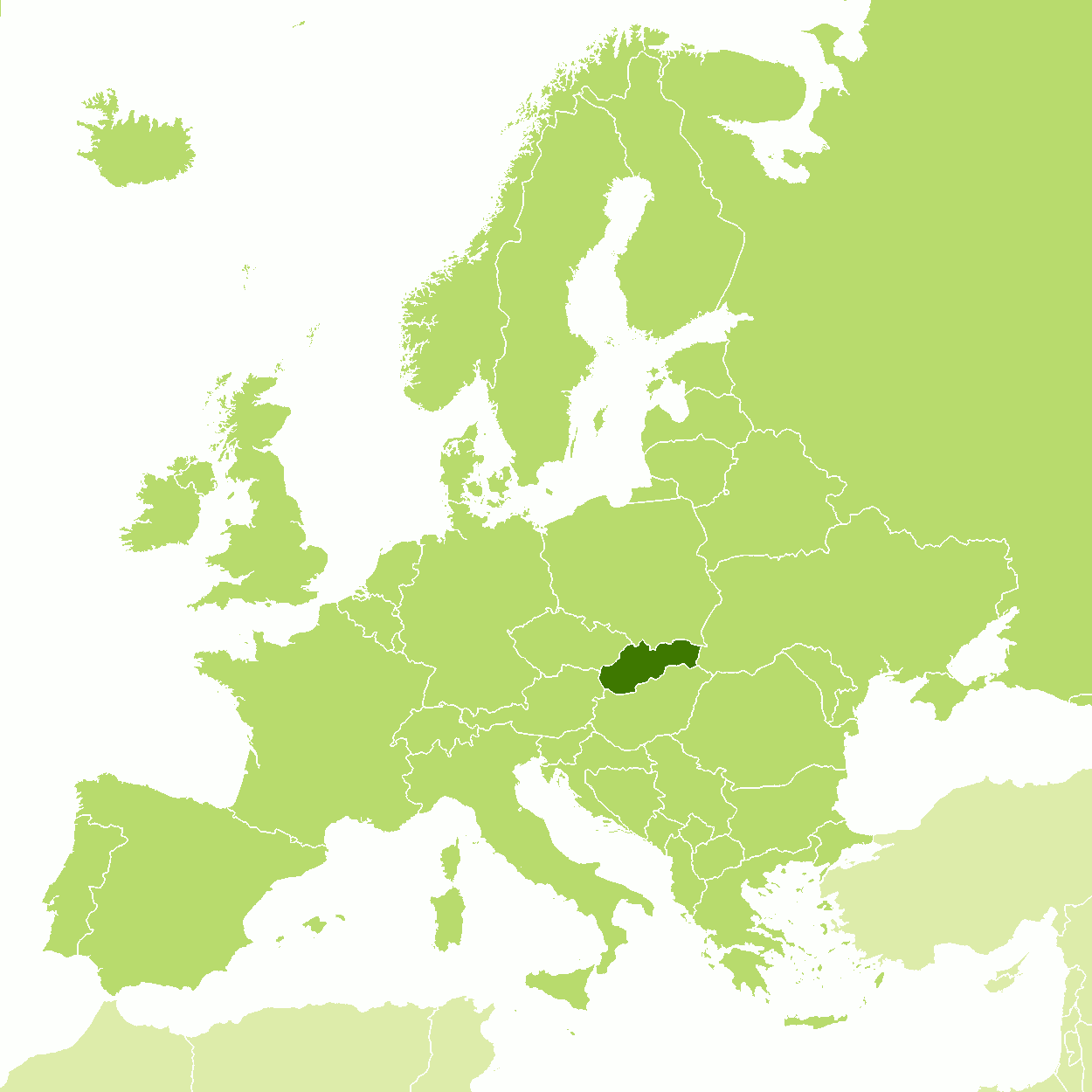The Climate of
Slovakia
 Bojnice Castle, Trenčín Region
Bojnice Castle, Trenčín Region
Climate Map
 Climate map of Slovakia
Climate map of Slovakia
What is the climate of Slovakia like?
Slovakia is a landlocked country located in Eastern Europe. Slovakia shares boundaries with Poland (on the north ), Ukraine (on the east), Hungary (on the south), and Austria and the Czech Republic (on the west). Slovakia is rather more hilly than the neighbouring Czech Republic and includes part of the western Carpathian mountains, whose higher peaks reach over 2,000 m/6,600 ft.
Slovakia has a continental climate with warm summers and cold winters. Mean temperatures are -1°C (30°F) in January and 21°C (70°F) in July. The chief differences of weather and climate within the country occur as a result of altitude. Higher elevations usually have a narrower temperature range but on average are considerably cooler. The Carpathians are wetter and more snowy than southern Slovakia. Otherwise there is little difference of weather from one area to another and everywhere it can be changeable at all times of the year.
December, January, and February are the coldest months; June, July, and August are the warmest. Spring tends to start late, and autumn may come abruptly in middle or late September. At lower elevations, frosts are rare between the end of April and the beginning of October. Rainfall also varies with elevation. The annual average precipitation in the lowlands is about 600 centimeters (24 inches); in the High Tatras, however, it can be more than twice as high.
The longest spells of settled weather occur during calm but cold days in winter; snow may lie from 40 to 100 days, depending on altitude and the nature of a particular winter. The most unpleasant weather occurs in winter when easterly winds from Russia may bring very low temperatures for several days on end.
When the systems to the north are weak, Mediterranean weather may occasionally reach the country. Spring and summer are the wettest seasons. Summers are moderately warm but fine weather is often broken by thunderstorms; extreme heat is rare. Spells of disturbed summer weather are often brought by disturbances originating over the northern Mediterranean. Although there is heavier rainfall in summer, it comes in sporadic showers, making for many warm, dry days with scattered cumulus clouds. The number of wet days is rather less than in western Europe and the number of hours of sunshine rather more. Summer sunshine averages as much as eight hours per day.
The climate of Bratislava (in the west) and Košice (in the east) are representative of lowland Slovakia.
| Climate data for Bratislava (1981–2010) | |||||||||||||
|---|---|---|---|---|---|---|---|---|---|---|---|---|---|
| Month | Jan | Feb | Mar | Apr | May | Jun | Jul | Aug | Sep | Oct | Nov | Dec | Year |
| Average high °C (°F) | 2.7 (36.9) | 5.1 (41.2) | 10.3 (50.5) | 16.7 (62.1) | 21.8 (71.2) | 24.9 (76.8) | 27.5 (81.5) | 27.0 (80.6) | 21.7 (71.1) | 15.6 (60.1) | 8.2 (46.8) | 3.3 (37.9) | 15.4 (59.7) |
| Daily mean °C (°F) | −0.4 (31.3) | 1.2 (34.2) | 5.5 (41.9) | 11.0 (51.8) | 16.0 (60.8) | 19.1 (66.4) | 21.3 (70.3) | 20.7 (69.3) | 15.9 (60.6) | 10.4 (50.7) | 4.9 (40.8) | 0.7 (33.3) | 10.5 (50.9) |
| Average low °C (°F) | −3.4 (25.9) | −2.3 (27.9) | 1.3 (34.3) | 5.4 (41.7) | 10.2 (50.4) | 13.4 (56.1) | 15.4 (59.7) | 15.0 (59.0) | 11.0 (51.8) | 6.1 (43.0) | 1.8 (35.2) | −1.9 (28.6) | 6.0 (42.8) |
| Average precipitation mm (inches) | 39 (1.5) | 37 (1.5) | 38 (1.5) | 34 (1.3) | 55 (2.2) | 57 (2.2) | 53 (2.1) | 59 (2.3) | 55 (2.2) | 38 (1.5) | 54 (2.1) | 46 (1.8) | 565 (22.2) |
| Average snowfall cm (inches) | 10.7 (4.2) | 5.7 (2.2) | 1.6 (0.6) | 0.2 (0.1) | 0.0 (0.0) | 0.0 (0.0) | 0.0 (0.0) | 0.0 (0.0) | 0.0 (0.0) | 0.2 (0.1) | 1.8 (0.7) | 4.0 (1.6) | 24.2 (9.5) |
| Source: Climatemps and Weather Atlas | |||||||||||||
| Climate data for Košice (1991−2020) | |||||||||||||
|---|---|---|---|---|---|---|---|---|---|---|---|---|---|
| Month | Jan | Feb | Mar | Apr | May | Jun | Jul | Aug | Sep | Oct | Nov | Dec | Year |
| Average high °C (°F) | 1.0 (33.8) | 3.7 (38.7) | 9.9 (49.8) | 16.5 (61.7) | 21.2 (70.2) | 24.8 (76.6) | 26.6 (79.9) | 26.8 (80.2) | 21.2 (70.2) | 14.8 (58.6) | 8.1 (46.6) | 1.8 (35.2) | 14.7 (58.5) |
| Daily mean °C (°F) | −2.6 (27.3) | −0.4 (31.3) | 4.5 (40.1) | 9.6 (49.3) | 14.6 (58.3) | 17.5 (63.5) | 19.3 (66.7) | 19.1 (66.4) | 14.8 (58.6) | 9.4 (48.9) | 3.0 (37.4) | −1.3 (29.7) | 9.0 (48.1) |
| Average low °C (°F) | −4.8 (23.4) | −3.5 (25.7) | 0.0 (32.0) | 5.0 (41.0) | 9.6 (49.3) | 13.2 (55.8) | 14.8 (58.6) | 14.6 (58.3) | 10.1 (50.2) | 5.3 (41.5) | 1.2 (34.2) | −3.3 (26.1) | 5.2 (41.3) |
| Average precipitation mm (inches) | 25.7 (1.01) | 26.8 (1.06) | 23.6 (0.93) | 42.4 (1.67) | 69.4 (2.73) | 87.5 (3.44) | 93.5 (3.68) | 66.5 (2.62) | 50.1 (1.97) | 51.1 (2.01) | 40.2 (1.58) | 36.1 (1.42) | 612.9 (24.12) |
| Source: World Meteorological Organization | |||||||||||||
References
- E. A. Pearce, Charles Gordon Smith, (1990) The Hutchinson World Weather Guide, John Murray Press. ISBN 1859863426
- Timothy L. Gall, (ed.), (2003), Worldmark Encyclopedia of the Nations, Eleventh Edition, Thomson Gale
- Federal Research Division, Library of Congress, (1989), Czechoslovakia: a country study. Claitor's Pub. Division.
- Hugh Chisholm, (ed.), (1911), Encyclopædia Britannica, Eleventh edition, Cambridge University Press
The Climate of
Slovakia

In summary:
Slovakia's climate is continental, with hot summers and cold winters. In July the mean temperature is 21°C (70°F). January’s mean temperature is –1°C (30°F). Rainfall averages roughly 600 mm (24 in) a year, butis higher in the mountains.